ignition BUICK SKYLARK 1993 Owners Manual
[x] Cancel search | Manufacturer: BUICK, Model Year: 1993, Model line: SKYLARK, Model: BUICK SKYLARK 1993Pages: 306, PDF Size: 15.84 MB
Page 63 of 306
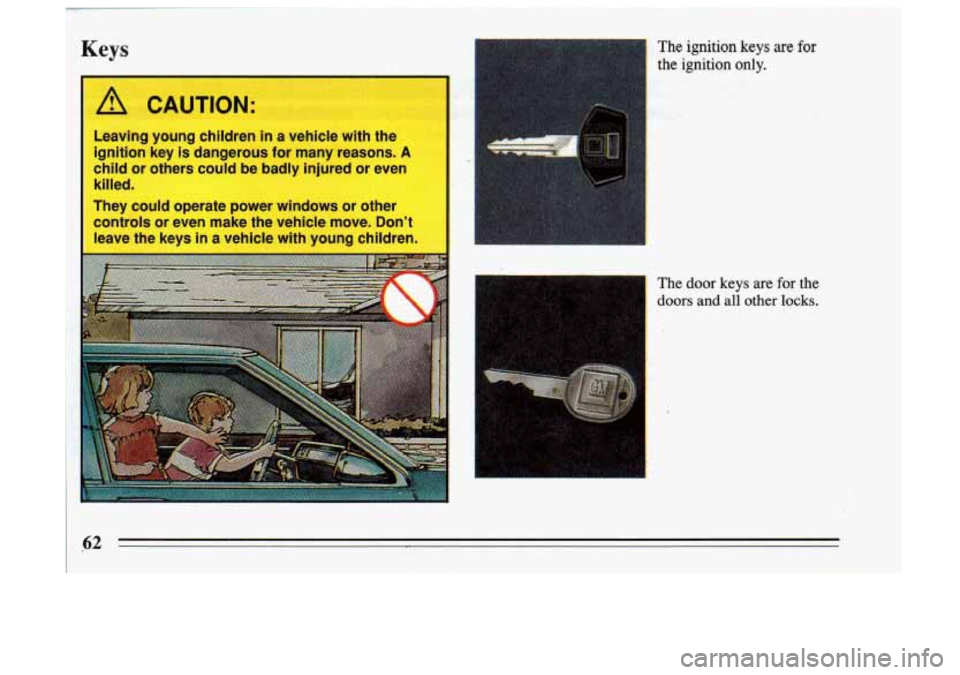
Keys
CAUTION:
Leaving young children in a vehicle with the
ignition key
is dangerous for many reasons. A
child or others could be badly injured or even
killed.
" I
I
I
The ignition keys are for
the ignition only.
The door keys are for the
doors and all other locks.
62
Page 66 of 306
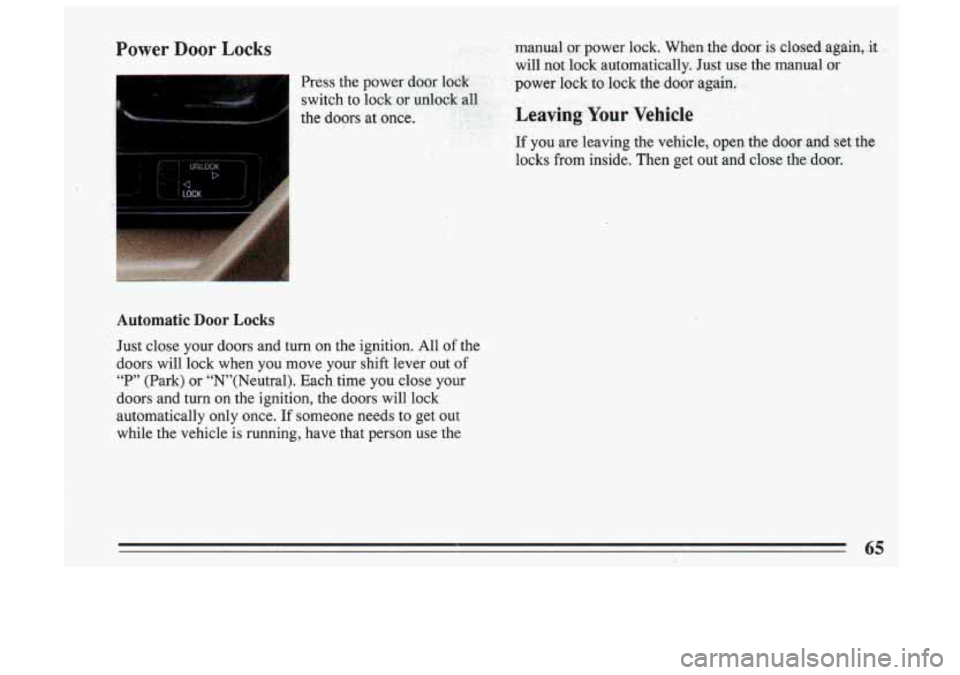
Power Door Locks
Automatic Door Locks
Just close your doors and turn on the ignition. All of the
doors will lock when you move your shift lever out of
“P” (Park) or “N’(Neutra1). Each time you close your
doors and turn on the ignition, the doors will lock
automatically only once.
If someone needs to get out
while the vehicle is running, have that person use the
65
Page 71 of 306
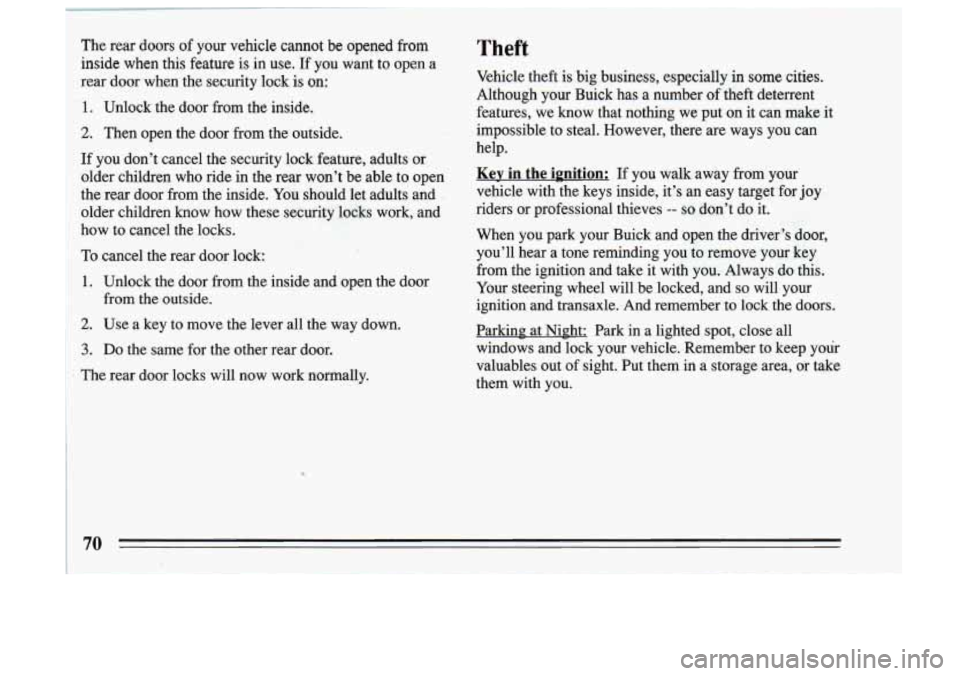
The rear doors of your vehicle cannot be opened from
inside when this feature is in use. If you want to open a
rear door when. the security lock is on:
1. Unlock the door from the inside..
2. Then open the door from the outside.
If you don’t cancel the security lock feature, adults or
older children who ride in the rear won’t be able to open
the rear door from the inside. You should let adults and
older children know how these security locks work, and
how to cancel the locks.
To cancel the rear door lock:
1. Unlock the door from the inside and open the door
2. Use a key to move the lever all the way down.
from the outside.
3. Do the
same for the other rear door.
. The rear door locks will now work norinally.
Theft
Vehicle theft is big business, especially in some cities.
Although your Buick has a number
of theft deterrent
features, we know that nothing we put on it can make it
impossible to steal. However, there are ways you can
help.
Kev in the ipnition: If you walk away from your
vehicle with the keys inside, it’s an easy target for
joy
riders or professional thieves -- so don’t do it. . .) ..
When you park your Buick and open the driver’s’a*oor,
you’ll hear a tone reminding you to remove your key
from the ignition and take it with you. Always do this.
Your steering wheel will be locked, and
so will your
ignition and transaxle. And remember to lock the doors.
: .+.,-:.,: <::: ., .,<. , p,
Parking at Night: Park in a lighted spot, close all
windows and lock your vehicle. Remember to keep your
valuables out of sight. Put them in a storage area,
or take
them with you.
Page 72 of 306
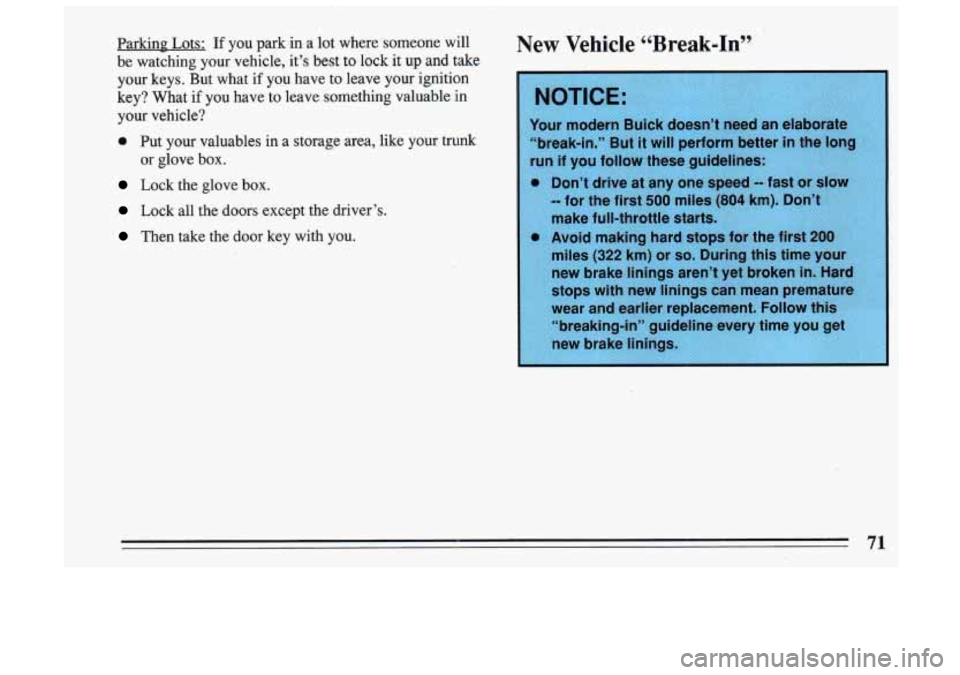
ParkinP Lots: If you parkin a lot where someone will
be watching your vehicle, it’s best to lock it up and take
your keys. But what
if you have to leave your ignition
key? What
if you have to leave something valuable in
your vehicle?
0 Put your valuables in a storage area, like your trunk
or glove box.
Lock the glove box.
Lock all the doors except the driver’s.
Then take the door key with you.
New Vehicle 6CBreak-In”
Page 73 of 306
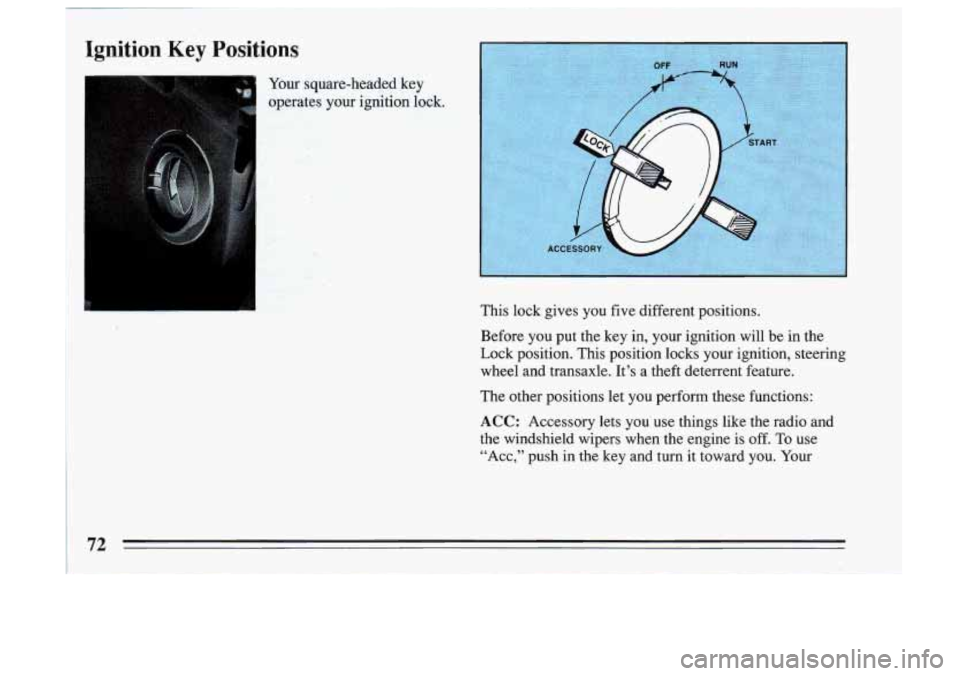
Ignition Key Positions
Your square-headed key
opgs.@gs ,. .r , your ignition lock. ..
This lock gives you five different positions.
Before you put the key in, your ignition will be in the
Lock position. This position locks your ignition, steering
wheel and transaxle. It’s a theft deterrent feature.
The other positions let you perform these functions:
ACC: Accessory lets you’use things like the radio and
the windshield wipers when the engine is
off. To use
“Acc,” push in the key and turn
it toward you. Your
72
Page 75 of 306
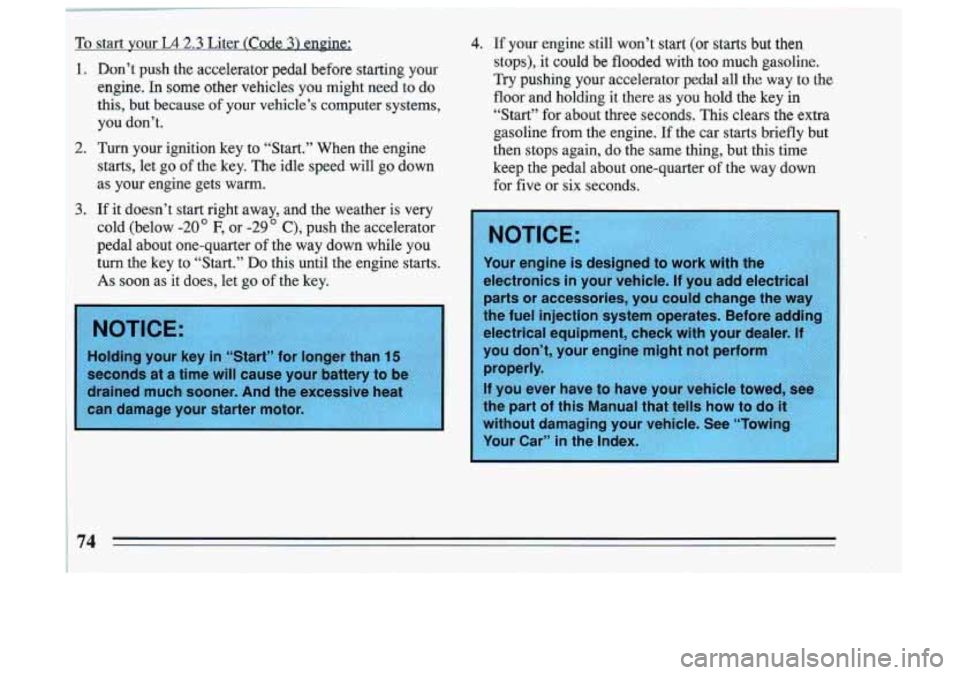
1 To start your L4 2.3 Lites (Code 3) engine:
I
Don’t push the accelerator pedal before starting your
engine. In some other vehicles you might need to do
this, but because of your vehicle’s computer systems,
you don’t.
Turn your ignition key to “Start.” When the engine
starts, let go of the key. The idle speed will go down
as your engine gets warm.
If it doesn’t start right away, and the weather is very
cold (below
-20’ .F, or -29’ C), push the accelerator
pedal about one-quarter of the way down while you
turn the key to
“Start.” Do this until the engine starts.
As soon as it does, let go of’the key.
4. If your engine still won’t start (or starts but then
stops), it could
be flooded with too much gasoline.
Try pushing your accelerator pedal all the way to the
floor and holding it there as you hold the key in
“Start” for about three seconds. This clears the extra
gasoline from the engine.
If the car starts briefly but
then stops again, do the same thing, but this time
keep the pedal about one-quarter of the way down
for five or six seconds.
electronics in your vehicle. If you add electrical
electrical equipment, check
you don’t, your engine rnigh
the part
of this Manual that tells how to do it
without damaging your vehicle. See “Towin
Your Car” in the Index.
74
Page 76 of 306
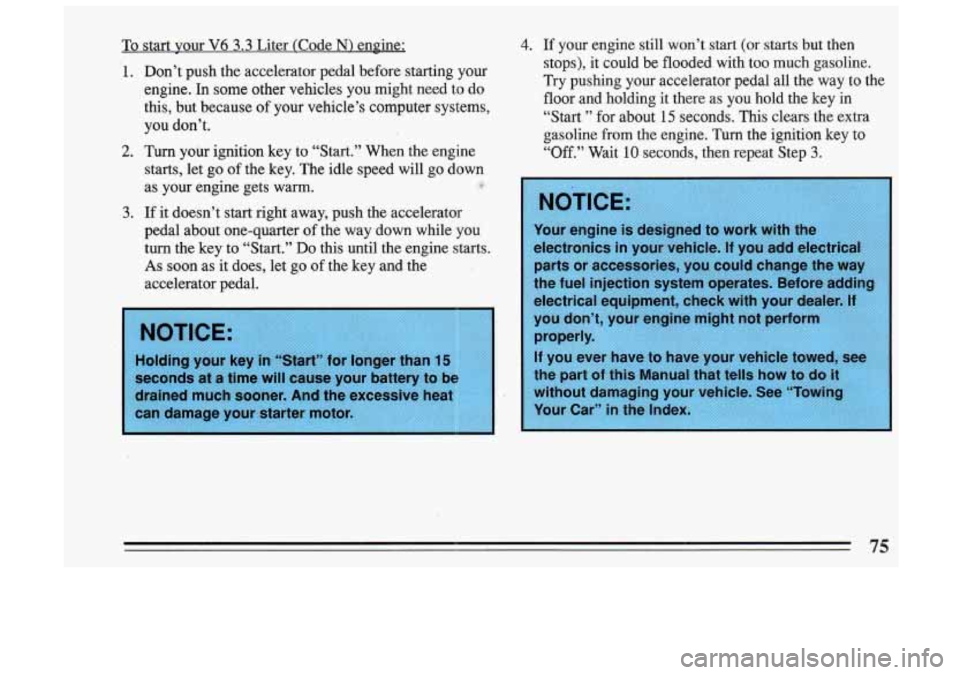
To start your V6 3.3 Liter (Code N) engine:
1.
2.
3.
Don’t push the accelerator pedal before starting your
engine. In some other vehicles you might need to do
this, but because
of your vehicle’s computer systems,
you don’t.
Turn your ignition key to “Start.” When the engine
starts, let go
of the key. The idle speed will go down
as your engine gets warm.
.4
If it doesn’t start right away, push the accelerator
pedal about one-quarter of the way down while you
turn the key to “Start.”
Do this until the engine starts.
As soon as it does, let go of the key and the
accelerator pedal.
4. If your engine still won’t start (or starts but then
stops), it could be flooded
with too much gasoline.
Try
pushing your accelerator pedal all the way to the
floor and holding
it there as you hold the key in
“Start
” for about 15 seconds. This clears the extra
gasoline
from the engine. Turn the ignition key to
“Off.” Wait 10 seconds, then repeat Step 3.
seconds at a time will cause your battery to be
drained much sooner. And the excessive heat
can damage your starter motor.
75
Page 78 of 306
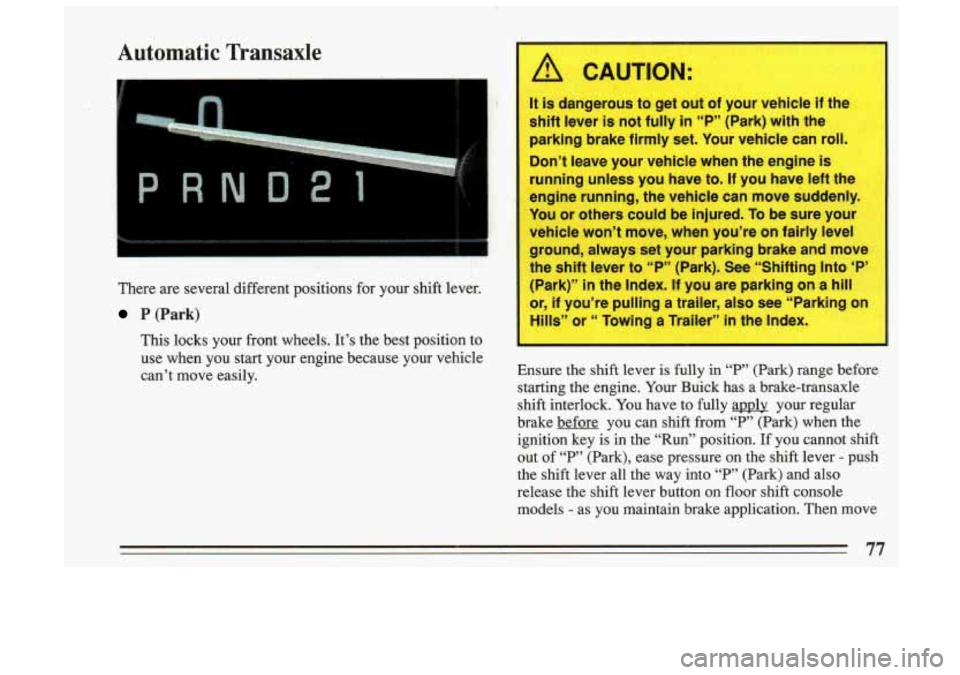
Automatic Transaxle
There are several different positions for your shift lever.
P.(Park)
This locks your front wheels. It’s the best position to
use when you start your engine because your vehicle
can’t move easily.
A CAUTION:
It is dangerous to get out of your vehicle if the
shift lever
is not fully in “P” (Park) with the
parking brake firmly set. Your vehicle can
roll.
Don’t leave your vehicle when the engine is
running unless you have to. If you have left the
engine running, the vehicle can move suddenly.
You or others could be injured.
To be sure your
ehicle won’t move, when you’re on fairly level
ound, always set your parking brake and move
e shift lever to
“P” (Park). See “Shifting Into ‘P’
ark)”
in the Index. If you are parking on a hill
, if you’re pulling a trailer, also see “Parking on
11s” or “ Towing a Trailer” in the Index.
Ensure the shift lever is fully in “P” (Park) range before
starting the engine. Your Buick has a brake-transaxle
shift interlock. You have to fully apply your regular
brake before you can shift from “P” (Park) when the
ignition key is in the “Run” position.
If you cannot shift
out of
“P” (Park), ease pressure on the shift lever - push
the shift lever all the way into
“P,’ (Park) and also
release the shift lever button on floor shift console
models
- as you maintain brake application. Then move
77
Page 83 of 306
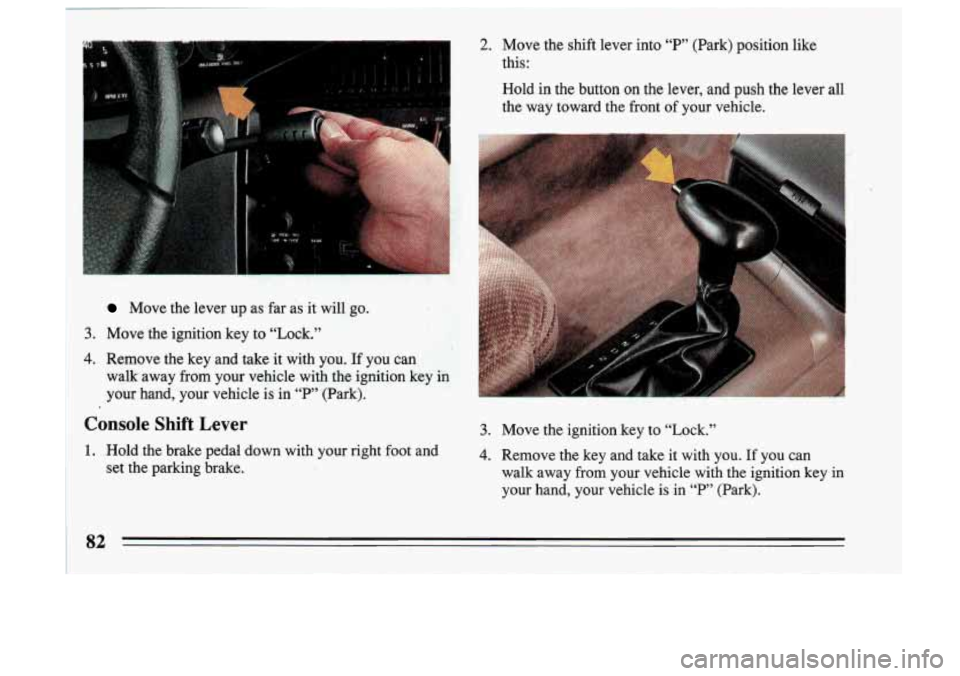
2. Move the shift lever into “P” (Park) position like
this:
Move the lever up as far is it will go.
3. Move the ignition key to “Lock.”
4. Remove the key and take it with you. If you can
walk away
from your vehicle with the ignition key-in
your hand, your vehicle is-in
‘‘P13 (Park).
Console Shift Lever
1. Hold the brake ped4 down with your right foot and
set the parking brake.
Hold in the button on the lever, and push the lever all
the way toward the front of your vehicle.
3. Move the ignition key to “Lock.”
4. Remove the key and take it with you. If you can
walk away from your vehicle with the ignition key in
your hand, your vehicle is in
“P” (Park).
82
Page 84 of 306
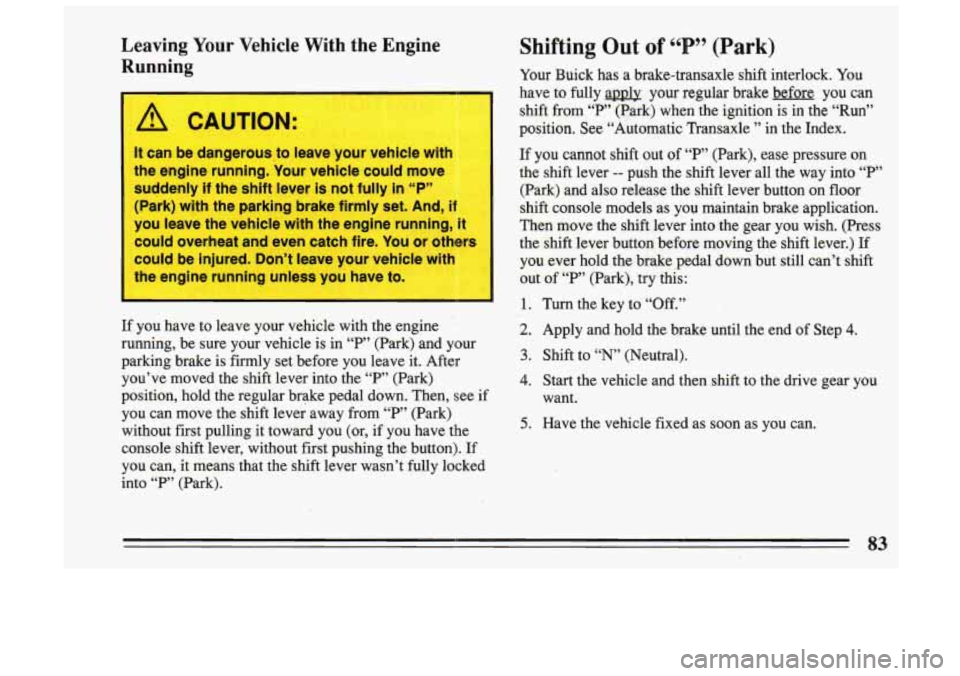
Leaving Your Vehicle With the Engine
Running
CAUTION:
It can be dangerous,to leave your vehicle with
the engine running. Your vehicle could move
suddenly
if the shift lever is not fully in “P”
(Park) with the parking brake firmly set. And,
il
you leave the vehicle with the engine running, it
could overheat and even catch fire. You or others
I
could be injured. Don’t leave your vehic ’ wi
the engine running unless you have to.
I
If you have to leave your vehicle with the engine
running, be sure your vehicle is in
“P” (Park) and your
parking brake is firmly set before you leave it. After
you’ve moved the shift lever into the
“P” (Park)
position, hold the regular brake pedal down. Then, see if
you can move the shift lever away from “P” (Park)
without first pulling it toward you (or, if you have the
console shift lever, without first pushing the button). If
you can, it means that the shift lever wasn’t fully locked
into
“P” (Park).
Shifting Out of P (Park) 66 99
Your Buick has a brake-transaxle shift interlock. You
have to fully applv your regular brake before
you can
shift
from “P” (Park) when the ignition is in the “Run”
position. See “Automatic Transaxle ” in the Index.
If you cannot shift out of “P” (Park), ease pressure on
the shift lever -- push the shift lever all^ the way into “P”
(Park) and also release the shift lever button on floor
shift console models as you maintain brake application.
Then move the shift lever into the gear you wish. (Press
the shift lever button before moving the
shift lever.) If
you ever hold the brake pedal down but still can’t shift
out of “P” (Park), try this:
1. Turn the key to “Off.”
2. Apply and hold the brake until the end of Step 4.
3. Shift to “N’ (Neutral).
4. Start the vehicle and then shift to the drive gear you
5. Have the vehicle fixed as soon as you can. want.